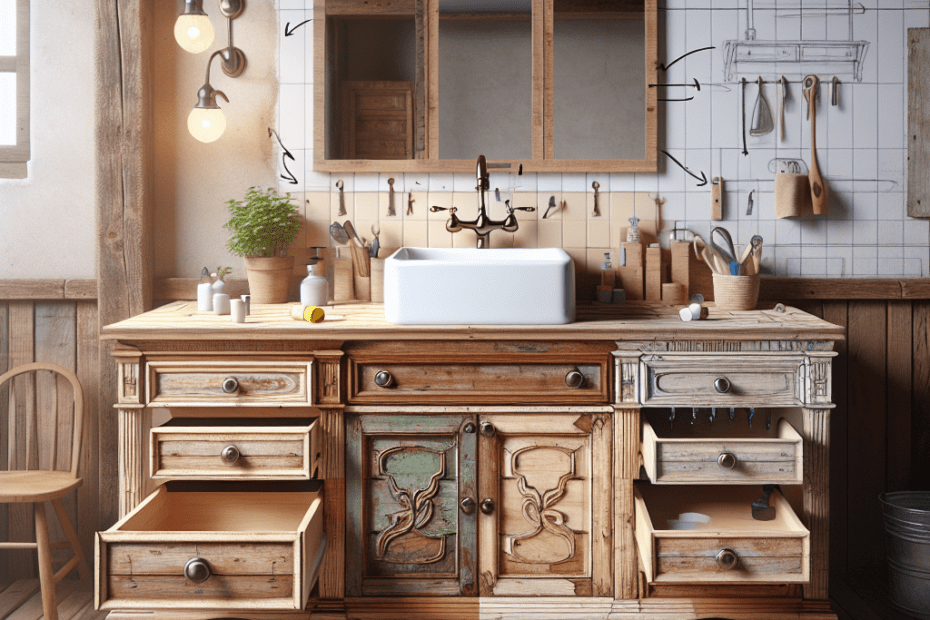“`html
Introduction
The farmhouse style has become an iconic design trend that brings a cozy and rustic charm to any home. Among the various ways to achieve this look, transforming old furniture pieces into new, functional items stands out as both economical and visually appealing. One popular project embraced by many is the upcycled dresser vanity farmhouse, giving a second life to outdated furniture while adding character to their bathrooms.
Upcycling: A Sustainable Choice
Upcycling involves creatively repurposing old materials, reducing waste, and limiting the need for new resources. According to a report by the EPA, the average American generates 4.9 pounds of waste daily, emphasizing the importance of sustainable practices like upcycling. Through projects such as turning a dresser into a vanity, they not only help the environment but also enjoy the satisfaction of crafting something unique.
The Attraction of Farmhouse Aesthetics
The farmhouse aesthetic appeals to many for its warmth, simplicity, and connection to nature. Elements such as distressed wood, neutral colors, and vintage touches create a space that is both inviting and timeless. By incorporating an upcycled dresser vanity farmhouse into their bathroom, they seamlessly merge function with style, using a piece that converses with the rest of their decor.
Steps to Upcycle a Dresser into a Bathroom Vanity
- Selection of the Dresser
Choosing the right dresser is crucial. They should look for a piece with sturdy construction, appropriate height, and enough depth to hold the sink. Consider the wood type and finish, as these factors influence the final look. - Preparation
Initial steps include cleaning and sanding the dresser. Sanding not only smoothens the surface but also prepares it for staining or painting, allowing them to apply their personal touch. - Cutting Openings for the Plumbing
Accurate measurements are key when cutting openings for the sink and plumbing. A jigsaw is usually recommended for this task. Careful planning will ensure that drawers or shelves remain functional without obstructing the piping. - Sealing
To protect against moisture in the bathroom, sealing the wood with a waterproof finish is necessary. This step prevents warping and prolongs the life of their vanity. - Final Installation
With the openings cut and finishing applied, they can proceed to install the sink and faucet. Attaching the plumbing comes next, and finally, they set the vanity in place, securing it for added stability.
Choosing Finishes and Accessories
Once the physical transformation is complete, the next focus is on finishes and accessories. Choices such as the type of hardware, lighting, and faucets greatly affect the overall style. Brass finishes exude a vintage charm, while matte black can offer a modern twist. Textiles like hand towels in muted or earthy tones accentuate the farmhouse theme.
| Feature | Farmhouse Option | Modern Option |
|---|---|---|
| Hardware Finish | Brass | Matte Black |
| Sink Style | Apron Front | Vessel |
| Faucet Design | Bridged Faucet | Single Lever |
Cost-Effectiveness
Repurposing a dresser into a vanity can be significantly more budget-friendly compared to purchasing custom cabinetry. Statistics from Remodeling Magazine’s Cost vs. Value report indicate that the average cost of a bathroom remodel can range from $20,000 to $30,000. By investing in an upcycled project, they can achieve a high-end look while maintaining control of their expenses.
Key Takeaways
- Upcycling promotes sustainability by reusing existing materials and reducing waste.
- The farmhouse style is characterized by its warmth, natural elements, and vintage appeal.
- An upcycled dresser vanity provides a cost-effective and customized bathroom solution.
- Selection of finishes and fixtures plays a crucial role in achieving the desired aesthetic.
FAQs
- What type of wood works best for an upcycled dresser vanity?
Solid woods like oak, maple, or pine are ideal due to their durability and ability to withstand humidity. - How can I maintain the dresser vanity?
Regularly cleaning and re-applying a waterproof finish will help protect against moisture damage. - Is it difficult to retrofit plumbing into a dresser?
It requires some carpentry skills, especially for cutting precise openings, but many find it manageable with proper tools. - Can I use any sink type with a dresser vanity?
Yes, both drop-in and vessel sinks work well, but they should ensure the dresser’s dimensions accommodate the chosen sink. - Does an upcycled dresser vanity suit small bathrooms?
Yes, by selecting a dresser proportional to the bathroom size, they can maintain functionality while enhancing the space’s aesthetic.
“`
